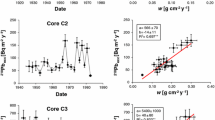Abstract
210Pb geochronologies should be validated with independent tracers such as 137Cs. In the cases with constant 210Pb activity in the topmost sediments, the presence of a distinct 137Cs peak within the 210Pb plateau has been used as a definitive demonstration of acceleration (increase in the sedimentation rate in recent years) versus fast mixing. Nevertheless, some limitations can be identified in the use of semiquantitative arguments, and a global understanding of the whole 137Cs activity profile is then required. Particularly, the incomplete mixing within the top sediment zone (described through the Incomplete Mixing Zone model) can explain quantitatively and simultaneously the 137Cs peak and the flattening in the 210Pb activity profile. This is demonstrated using selected examples from literature data. Thus, measured constant 210Pb activities in the top 6 cm of a sediment core from Lake Zürich. Nevertheless, they found 7Be only in the uppermost layer, the distinct 137Cs maximum at 6 cm depth, and undisturbed varves. The fast mixing seemed then opposed to common sense. The constant rate of supply model shows acceleration and it adequately matches the position of the 1963 137Cs peak. Nevertheless it fails to explain the whole 137Cs profile when handling time series of 137Cs atmospheric deposition. Finally, it is shown how the incomplete mixing of the activity (through the pore water) over a certain mass depth at the top sediment, with a finite value of the mixing coefficient, can quantitatively explain the whole activity versus mass depth profiles of 137Cs and 210Pb, and the presence of 7Be only in the uppermost sediment layer. A further validation of these ideas is presented from other literature data.
Similar content being viewed by others
References
Abril J.M., García-León M., García-Tenorio R., Sánchez C.I. and El-Daoushy F. 1992. Dating of marine sediments by an incomplete mixing model. J. Environ. Radioactivity 15: 135-151.
Appleby P.G. 1998. Dating recent sediments by 210Pb: problems and solutions. In: Ilus E. (ed.), Dating of Sediments and Determination of Sedimentation Rate. Stuk A145. Helsinki, pp. 7-24.
Appleby P.G. 2000. Radiometric dating of sediment records in European mountain lakes. Limnol. 59(Suppl. 1): 1-14.
Appleby P.G. 2001. Chronostratigraphic techniques in recent sediments. In: Last W.L. and Smol J.P. (eds), Tracking Environmental Change Using Lake Sediments. Basin Analysis, Coring, And Chronological Techniques. Developments in Paleoenvironmental Research. Kluwer Academic Publishers, Dordrecht, pp. 171-203.
Appleby P.G. and Oldfield F. 1978. The concentration of lead-210 dates assuming a constant rate of supply of unsupported 210Pb to the sediment. Catena 5: 1-8.
Christensen E.R. and Bhunia P.K. 1986. Modelling radiotracers in sediments: comparison with observations in Lakes Huron and Michigan. J. Geophys. Res. 91: 8559-8571.
Delaune R.D., Patrick W.H.Jr. and Buresh R.J. 1978. Sedimentation rates determined by 137Cs dating in a rapidly accreting salt marsh. Nature 275: 532-533.
El-Daoushy F. 1988. A summary of the lead-210 cycle in nature and related applications in Scandinavia. Environ. Internat. 14: 305-319.
Erten H.N., von Gunten H.R., Rössler E. and Sturm M. 1985. Dating of sediments from Lake Zurich (Switzerland) with 210Pb and 137Cs. Schwiz. Z. Hydrol. 47: 5-11.
IAEA 1985. Sediment Kds and Concentration Factors For Radionuclides in the Marine Environment. Iaea Technical Reports Series N° 247. Vienna.
Robbins J.A. 1978. Geochemical and geophysical applications of radioactive lead isotopes. In: Nriago J.P. (ed.), Biochemistry of Lead in the Environment. Elsevier, Amsterdam, pp. 285-393.
Robbins J.A. and Edgington D.N. 1975. Determination of recent sedimentation rates in Lake Michigan using 210Pb and 137Cs. Geochim. Cosmochim. Acta 39: 285-304.
Santschi PH. and Honeyman B.D. 1989. Radionuclides in aquatic environments. Rad. Phys. Chem. 34: 213-240.
Santschi PH., Laodong G., Asbill S., Allison M., Kepple A.B. and Liang-Saw W. 2001. Accumulation rates and sources of sediments and organic carbon on the Palos Verdes shelf based on radioisotopic tracers (137Cs, 239+240Pu, 210Pb, 234Th, 238U and 14C. Marine Chem. 73: 125-152.
Smith J.N. 2001. Why should we believe 210Pb sediment geochronologies? J. Environ. Radioactivity 55: 121-123.
von Gunten H.R., Sturm M., Erten H.N., Rössler E. and Wegmüller F. 1987. Sedimentation rates in the central Lake Constance determined with 210Pb and 137Cs. Schweiz. Z. Hydrol. 49: 275-283.
Wan C.J., Santschi PH., Sturm M., Farrenkothen K., Luek A., Werth E. and Schuler Ch. 1987. Natural (210Pb,7Be) and fallout (137Cs,239,240Pu, 90Sr) radionuclides as geochemical tracers of sedimentation in Greifensee, Switzerland. Chem. Geol. 63: 181-196.
Waugh W.J., Carroll J., Abraham J.D. and Landeen D.S. 1998. Applications of dendrochronology and sediment geochronology to establish reference episodes for evaluations of environmental radioactivity. J. Environ. Radioactivity 41: 269-286.
Author information
Authors and Affiliations
Rights and permissions
About this article
Cite this article
Abril, J. Difficulties in interpreting fast mixing in the radiometric dating of sediments using 210Pb and 137Cs. Journal of Paleolimnology 30, 407–414 (2003). https://doi.org/10.1023/B:JOPL.0000007231.92183.b9
Issue Date:
DOI: https://doi.org/10.1023/B:JOPL.0000007231.92183.b9




